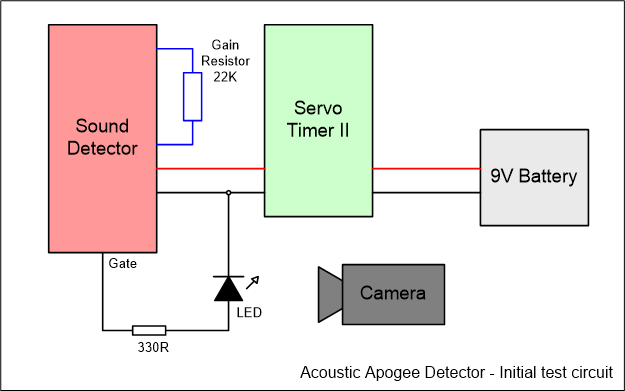| Date: | 30th July 2016 |
| Location: | Whalan Reserve, Australia |
| Conditions: | Clear skies, calm,, 18C |
| Members: | PK, GK, Paul and John K |
When we edit videos with on-board footage a common signature that we always see is the sound the camera captures during flight. Very loud ascent that eventually diminishes to a low level and then begins to increase again as the rocket starts to accelerate on the way down. Here are some examples of sound waveforms captured on different flights.

We've always wondered if this could be used to detect apogee and deploy the parachute. This really wouldn't have any advantages over say a barometric sensor that is far more sensitive and can read absolute pressure. You also wouldn't be able to use the sound to measure altitude for example. This experiment was purely to see if it could be done and how reliable such a system would be.
The circuit we used for this experiment is based on the Sound Detector from SparkFun Electronics.
Originally the idea was that the microphone could also be used to detect launch. But we decided to use a break wire instead so that any noise at the launch pad would not trigger the detector. The intention is that apogee will be detected when the sound level first increases during acceleration then decreases during deceleration and finally increases again meaning that it would have had to have gone through apogee and is on the way down. Apogee should still be detectable even if the rocket is flying in an arc and still producing some amount of noise.
The first set of trial flights were intended to see how the Sound Detector circuit behaves in flight without being used for parachute deployment. We also wanted to get an idea of the best gain to set it at so we could get fairly sensitive detection without overly saturating the signal with too much noise. The microphone was just left out in the air stream to listen to the noise of the wind rushing past.
We wired an LED to the gate output to show when the sound level would drop below a certain threshold. We then mounted a camera near the LED so that we could watch what the circuit did in relation to the flight.
Here is the circuit diagram for this experiment:

With this setup we weren't really detecting apogee, we were just seeing when the sound level dropped below a certain threshold near apogee. The final implementation will allow the rocket to pass through apogee as the sound level starts to increase again.
Of the 4 test flights, all showed good promise with the LED turning off just before apogee. This was simply the rocket dropping below a certain air speed.
We tested the following gain resistors on the 4 flights (47K, 47K, 100K, 22K). We have decided to go with the 22K (18dB gain) for the final circuit.
So overall the sound detector seemed to work fairly well under these conditions. The next set of tests will involve using the envelope output of the sound detector and processing that via a Pro Micro controller also from Sparkfun. We decided to use this micro-controller for the experiment as it has an analog input, runs from 5V and has direct USB connectivity. We may simply use it to detect apogee and then trigger the Servo Timer II to do the actual deploy. The STII will provide 5V power to the Sound Detector and the Pro Micro as well.
See Day 181 for Part #2 and details of the final circuit.
| Launch | Details | ||||||||||||||||||||||||
| 1 |
|
||||||||||||||||||||||||
| 2 |
|
||||||||||||||||||||||||
| 3 |
|
||||||||||||||||||||||||
| 4 |
|
||||||||||||||||||||||||
| 5 |
|
||||||||||||||||||||||||
| 6 |
|